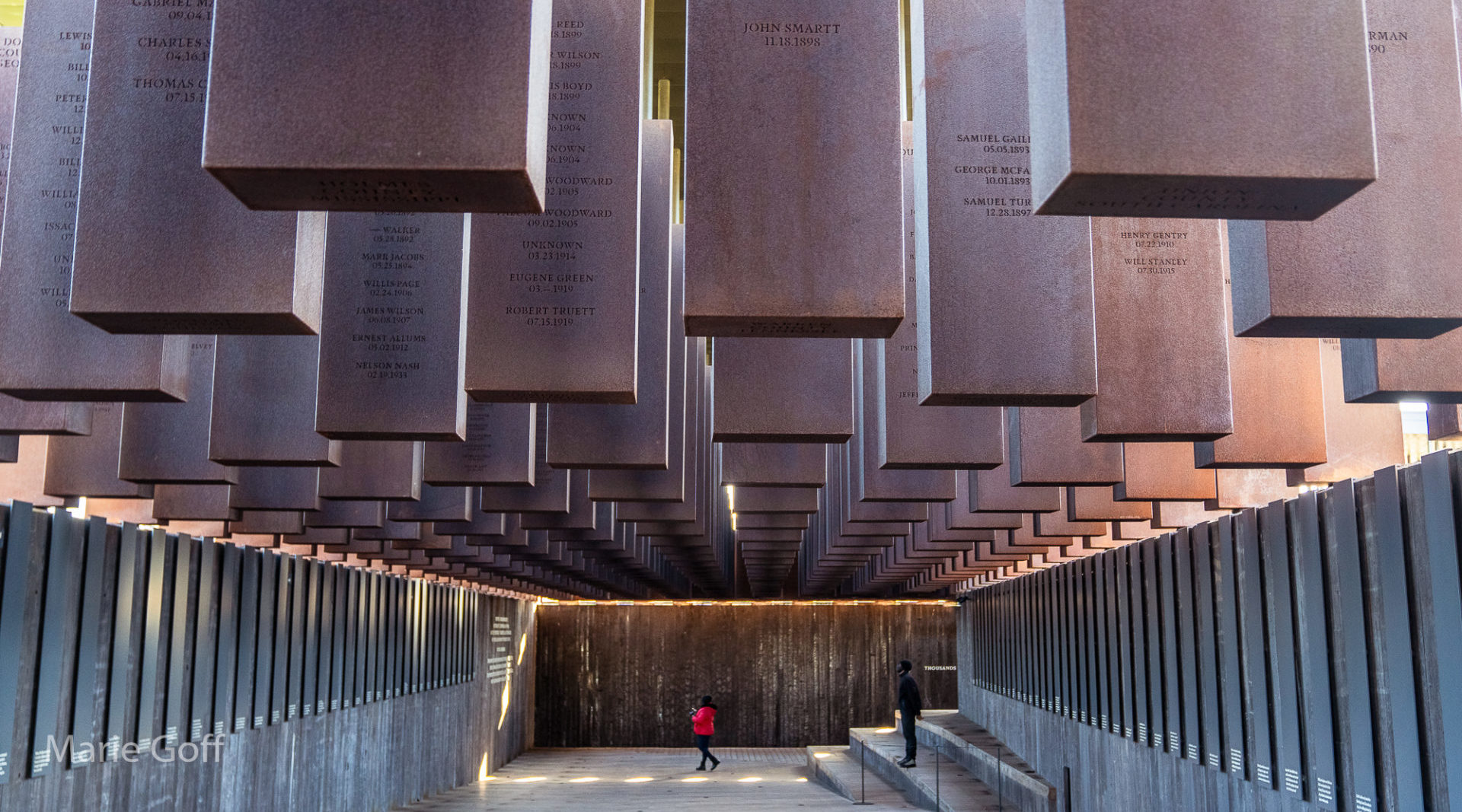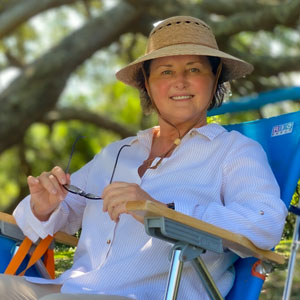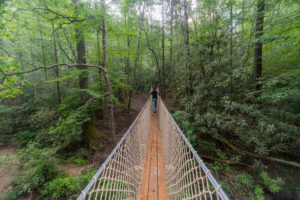Gain a better understanding of the African American Experience and its impacts today – Tour Montgomery, Alabama.
“This past remains a painful truth for all who lived it. Rather than be ignored or denied, it must be acknowledged and its impact understood in order to reconcile our collective history.” – Marble slabs displayed at Kress Building in Montgomery, Alabama.

Tour Montgomery, Alabama, for a better understanding of the African American experience in the South – and its impacts today. Montgomery is home to ten stops on the Civil Rights Trail, a museum, a memorial, and a statue of Rosa Parks, plus much more.
Friends Renita, Valerie, and I started on foot in the downtown area with Jake Williams from Tours by Locals. The day was sunny, and our mood was lighthearted. We stopped at the former Kress store (1929), where we saw marble slabs engraved with “colored” and “white” markings. These words once stood above two water fountains in the days of segregation. Today, they provide a symbol of Jim Crow laws in effect in the South during that time (Post Civil War to 1968).

Montgomery Bus Boycott (1955 – 1956)
Rosa Parks (1913-2005) is the “Mother of the Civil Rights Movement.” Her name and image are omnipresent in downtown Montgomery. Look across the street from Kress Department Store and see her picture in the window where she worked. Pose for a photo with her statue on the corner near the bus stop she used.

The Rosa Parks Museum is down the street near the place where police arrested her on December 1, 1955. The bus driver asked Rosa to move to allow a white passenger to sit, even though she was sitting in a seat assigned to colored people by city ordinance. Rosa refused, and the quote in the window near her picture explains why.
“The only tired I was, was tired of giving in.” -Rosa Parks

Rosa Parks’ actions sparked the Montgomery Bus Boycott, and 40,000 African Americans refused to ride the buses. Tensions led to violence, and finally, after 381 days, the courts ruled bus segregation unconstitutional. It was the first large-scale demonstration against segregation in the U.S.
In the meantime, Dr. Martin Luther King Jr. emerged as the leader of the Civil Rights Movement. In retaliation, segregationists bombed the parsonage where Dr. King lived. Now, at the Dexter Parsonage Museum, a plaque indicates where the bomb exploded.
Selma-to-Montgomery Voting Rights March (1965)
The footprints of giants are on the street in front of the State Capitol Building in Montgomery. They represent 2000 people who participated in the Selma-to-Montgomery Voting Rights March. State Troopers brutally attacked the marchers when they crossed the Edmund Pettus Bridge on the first attempt, known as Bloody Sunday.
Valerie, Renita, and Jake are standing in the footsteps of 2000 giants.

With National Guard protection, the marchers reached the Capitol in Montgomery five days after they started on March 21, 1965. Dr. King delivered the Voting Rights speech to the Governor, titled “How Long; Not Long.” Congress passed the Voting Rights Act, which followed the passing of the Civil Rights Act just a few months before.
Dr. King directed the Bus Boycott from the Dexter Avenue King Memorial Baptist Church office, where he was the pastor. The church is a National Historic Landmark on the National Register for Historic Places.

The Equal Justice Initiative is a nonprofit organization that created the Legacy Museum and the National Memorial for Peace and Justice. They tell the history of the African American experience in the South and its impacts today in meticulously researched detail.
The Legacy Museum: From Enslavement to Mass Incarceration

Our moods changed from light to heavy-hearted as we entered the Legacy Museum. There, just inside the door, are lifesize hologram videos of tormented slaves, each in a holding pen awaiting auction. As you walk close, they come to life and provide first-person narrations of their plight. The location of the Museum is not far from the area where slaves awaited auction in the same manner during the times of slavery.
The first image sings African American spirituals, deftly providing a heartbreaking account of how they dealt with the hardships of slavery through religious songs.
The next section of the Museum shows the historical African American experience in the South, from Kidnapping (slavery), Terror (lynching violence), and Segregation (Jim Crow Laws) to mass incarceration (War on Drugs). The Museum uses technology and imagery to display massive and easily accessible information, exposing each period’s full depth and breadth.
Photos in the Museum show the reality of the period, and I’d seen them in documentaries, but this was different.
The Museum has one of the lynching photos enlarged to life-size and hanging overhead.
It was a time when lynchings were acceptable, even anticipated by thousands. I learned that entire families attended and planned for it as a picnic, selling postcards with the pictures.
Continue through the Museum and sit at a booth replicating the visitation area of a prison. Pick up the receiver there and talk to an inmate. Using hologram and video technology, the prisoners’ images appear as real as the stories they tell.
The Legacy Museum experience is visceral and, at times, overwhelming. There’s no way to capture its impact in writing, and no pictures are allowed inside. You must see it firsthand.
Visit the EJI Gift Shop, Café, and bookstore next to the Museum. Purchase concise reports of each period of the African American experience in the South as outlined in the Museum and other books and materials.
National Memorial for Peace and Justice
Our hearts were heavy as we continued to the National Memorial for Peace and Justice. Yet the lifesize sculpture at the entrance plunged us into greater depths of melancholy. The sculpture called “Nkyinkyim Installation” is by Ghanaian artist Kwame Akoto-Bamfo. The name is from a proverb. It’s related to the journey of the ancestors, where they are from, and the twists and turns of the art installation documenting their journey.
With expressions of terror, slaves are coffled in chains. Their posture indicates a heart-wrenching woe. The artist captured their torment. The sculpted people looked so wretched that I avoided using a closeup picture. Go and see for yourself.

Walking uphill, as if going to a lynching, we began to encounter row after row of hanging stelai (slabs). Each slab represents each county in the United States where lynchings occurred and the names of people lynched.
“The patina of the slabs is like blood, and water running over the concrete below is like tears.” – the guide who pointed the way to go.

Across the street, the Peace and Justice Memorial Center holds the documentation of over 4000 souls represented by the hanging slabs, and the list is growing. The Legacy Museum and the National Memorial for Peace and Justice have thousands of sad stories to tell.

Our guide, Jake, showed us more historic sites, including his alma mater, Alabama State University. Our spirits began to lift in the inspirational atmosphere of Montgomery. Downtown streets sparkled, and structures invited us to explore. New and historic architecture intermingle in a way that invites curiosity.
Even the restaurants and coffee shops highlight the African American experience in the South. They are connected to the spirit of remembering the past with a positive outlook towards the future.
We stopped for a late-night cup of coffee at Prevail.
Prevail Union Montgomery Craft Coffee features the best drip coffee with a quote that inspires their name.
“Man will not merely endure, he will prevail…because he has a soul, a spirit capable of compassion, sacrifice and endurance” – William Faulkner.

About our guide Jake at Tours by Locals
Jake is a child of the Civil Rights Movement and participated in the Selma to Montgomery Voting Rights March. He was raised in Lowndes County, the site of two of the most violent acts of the Civil Rights Movement. Gunmen murdered Mrs. Viola Liuzzo and Jonathan Daniels on separate occasions while they participated in Voting Rights activities. Jake’s unique historical perspective comes from his participation in mass meetings and protests that registered Blacks to vote.
This WEBINAR features Jake as a guest with TRIPSCHOOL, and an Australian Actor/Filmmaker interviews him in this PODCAST.
“Montgomery is a city that has been peculiarly touched by the great events of American history. The Southern Confederacy was formed here that set in motion our nation’s bloodiest cataclysm, the American Civil War.” – Jake.

A tour of Montgomery, Alabama, leads to a better understanding of the African American experience in the South – and its impacts today. The Legacy Museum and the National Memorial for Peace and Justice continue to seek and present the truths uncovered by diligent research. It is up to all of us to learn, reflect, and educate.
Tours by Locals enhance the experience by providing knowledgeable guides with a historical perspective, and they also know the best places to eat.
These local Montgomery restaurants offer some of the best food we’ve had anywhere.
- Mama’s Sack Lunches is the best place for anything; it is exceedingly good.
- Cahawba House is best for jams, jellies, and honey.
- Wintzell’s Oyster House has served delicious fresh seafood in a down-home atmosphere for 75 years.
- Capitol Oyster Bar & Grill has great food overlooking the Alabama River and features the best blues singers.

About Renita

Renita Berry, Col, USA Retired, served in the South Carolina National Guard for 35 years. Her distinguished career includes deployments to Bosnia and Kosovo. She served in positions as Brigade Commander and State Logistics Officer before retiring. Renita is the Director of the Forensic Services Laboratory at Beaufort County Sheriff’s Office.
About Valerie

Valerie Webb is married and the mother of two beautiful daughters. She is an analyst who enjoys photography, reading, crafting, and traveling with family and friends. She graduated from Benedict College and then earned an MBA from Strayer University. Valerie is a motivator and a change agent for improving and encouraging others to find joy in everything around them.
We didn’t know what to expect in Montgomery and almost didn’t go. An angry mob crashed into the U.S. Capitol nine days before our visit. Police in state capitols around the country were preparing for violence. Plus, infections from the COVID-19 virus were on the rise. But, we had hired a guide and followed guidelines to protect ourselves and others from the virus.
It was dark when we checked into our hotel. The desk clerk assured us the streets were safe, and we walked downtown to dinner. Montgomery was peaceful and beautiful, particularly at night. Renita summed up the experience with this remark.
“The city has gracefully embraced a very dark history and offers the world a chance to embrace it too,” said Renita Berry.

More cultural history at Travel Notes and Storytelling
- A New Beginning in Ajijic, Mexico
- Immersion in Hawaiian Culture and History on a visit to Oahu
- Ybor City – Tampa’s Cigar Heritage
- Colorful Cooking Experience in Bo-Kaap
- Mexico – A Magical Inland Visit
Travel Notes
The Equal Justice Initiative had specific objectives when it set out to build the Legacy Museum and the National Memorial for Peace and Justice. Included in these are “truth-telling, reflection, and education, as outlined on their website, eji.org
Renita, Valerie, and I found the truth-telling at these two sites accompanied by a range of emotions from disbelief, sadness, outrage, and finally…an attempt to see the way forward. They are meant to be that way.
The way forward involves reflection and almost always ends with more questions than answers. I began asking myself how my experiences and personal connection to race relations shaped who I am today. What can I recall about these relationships growing up in my family, community, schools, and workplaces?
The U.S. Supreme Court ruled segregated schools unconstitutional in 1954; however, my schools in Ninety Six, SC. didn’t desegregate until 1973, 19 years later. Yet, neither my close-knit group of high school friends nor I remember any significant race problems during desegregation. There must have been resistance on a larger scale years earlier, for which we waited 19 years to desegregate. The things I learned in Montgomery are only vague memories of the news I saw as a child or books I might have read.
Questions arise when I consider my early working days. Did my experiences in these early jobs confirm or deny what I learned about the African American experience in Montgomery?
I started working in textile mills when I was sixteen, and I don’t remember any African Americans there. Textile mills were still a huge part of the economy in 1970. There was almost nowhere else to work in industry where I grew up in the Piedmont of South Carolina. So, where did African Americans work then?
When I was 21 and fresh out of college, and had completed U.S. Army Basic Combat Training, I began working in law enforcement. I went from a patrol officer in my hometown of Ninety Six, S.C., county deputy in Greenwood, S.C., to educator at Piedmont Technological College in Greenwood, S.C. One of my teaching duties was Adult Basic Education (ABE) at Greenwood Correctional Center.
My students at Greenwood Correctional Center were mostly African American (one-room schoolhouse in the back of the Warden’s office). That’s telling, considering that my class was mandatory for inmates who wanted to learn carpentry and didn’t have a high school diploma or equivalency.
Books and Periodicals
A highlighted statistic caught my attention in the Legacy Museum. “In 1972, 300,000 people were incarcerated in the U.S. Today, there are 2.3 million.”
This statistic above is attributed to the Nixon Administration’s War on Drugs, which is alleged to have come from the “desire to criminalize African Americans, ” the words of Journalist Shane Bauer in his book.
American Prison: A Reporter’s Undercover Journey into the Business of Punishment, Sep 2018, by Shane Baur.
Studies show the number of African American incarcerations See the (prison policy initiative).
Robert E. Lee and Me: A Southerner’s Reckoning with the Myth of the Lost Cause, January 2021, by Ty Seidule.
Marie Goff







